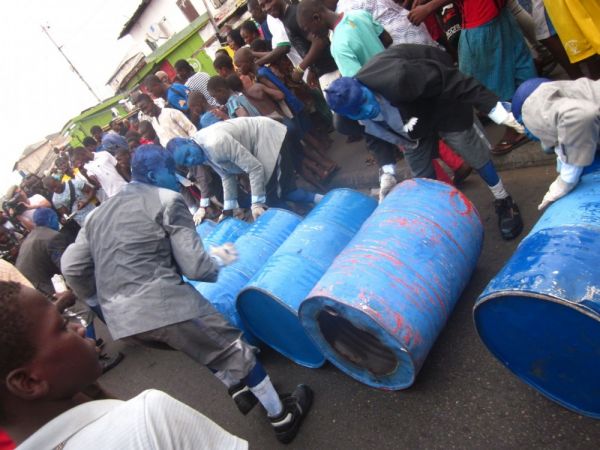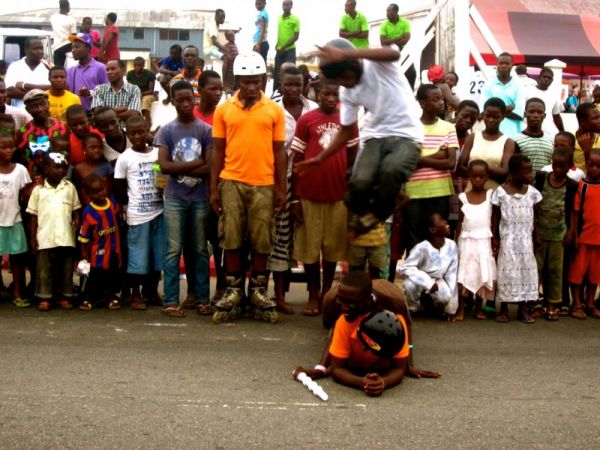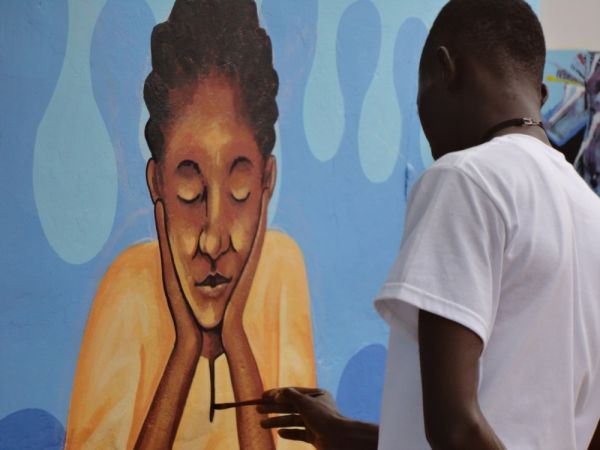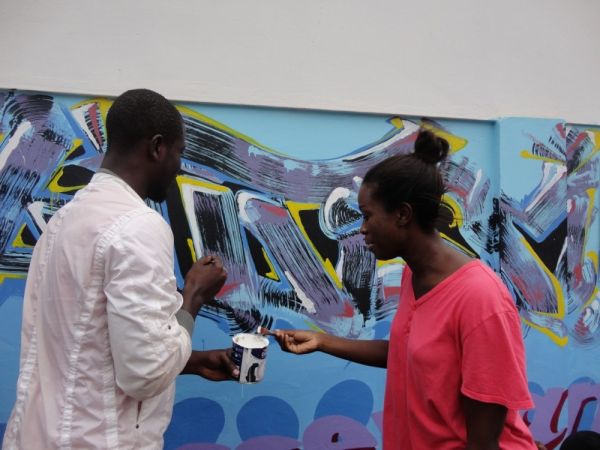Festival Aims to Prove Art Can Directly Benefit a City’s Poorest Citizens

The Chale Wote Street Art Festival in 2012.
One of my fondest memories of my early time in Accra is having a beer at the Sea View Hotel in Jamestown on the evening of the Chale Wote Street Art Festival in 2012. The historic but slowly crumbling aquamarine building overlooks the open square in front of the Ga Mantse’s palace, the home of the traditional leader of the Ga people. Onlookers were gathering in the square, in anticipation of the concert that would top off the festival. We waited – as we often wait – while the power was off and the sound system therefore down, drinking beer and relaxing after a day packed with arts activities along the length of High Street.
The festival’s organizers, Dr. Sionne Neely and Mantse Aryeequaye of Accra[dot]Alt, deliberately chose to hold the participatory arts festival here in the heart of Accra, where High Street runs through the historically significant but low-income and overcrowded Ga community. “With Chale Wote,” Dr. Neely says, “we advocate that every one of us is an artist…Each of us has the capacity to change not only our own lives but that of our communities. It’s not just reserved for those who have money or privilege.” Even the name Chale Wote – slang for flip-flops – evokes bonds that transcend social class. “Everyone wears chale wote, no matter where you come from,” says Dr. Neely.
In 2011, an Accra-based blogger wrote a scathing review of the first Chale Wote. Some of her more aesthetic critiques were at least somewhat valid, if perhaps a bit premature, judging a newborn festival by the standards set by well-funded and well-established European and American arts festivals. Another, deeper question that the blogger asked, though, is worth serious consideration. It can be summarized in the Pidgen phrase, “E be art we go chop?” or, “Can we eat art?” Put another way, in low-income communities with huge challenges like crowding, limited access to basic sanitation facilities and limited economic prospects, what is the point of spending time and resources on artistic initiatives?

Performers at last year’s Chale Wote Street Art Festival.
These kinds of questions are asked by many. The answer is complicated, as it always is when you are talking about things you can’t easily measure. Kobby Graham, a lecturer at Ashesi University College and an active participant in Accra’s art scene, says, “The arts speak to the national imagination. It is how we dream ourselves out of our present circumstances. Ghana has only existed for 60 years. It needs symbols, things to gel it together. Such things come out through art, culture and imagination. [Kwame] Nkrumah understood this. He supported the arts.”
Dr. Neely agrees. “Art is just so necessary,” she says, “because it allows the creation of a different set of possibilities. Art can be the critical engine of transformation.”
Echoing both Graham and Dr. Neely is Larry Aminu, one of three co-founders of Nima Muhimanchi Art (NMA), an arts collective based out of Nima, one of Accra’s largest slums. “Art is the only medium that can transform society,” Aminu says. “Art can bring peace. Art can bring unity. Art can bring togetherness. I do art to change society. I also do art to talk for those who cannot speak for themselves.”
NMA’s artists, mostly self-taught and born and raised in the slums, are responsible for a series of conspicuous public murals on the busy Kanda Highway, bordering one side of Nima. NMA’s “Imagine Accra” mural is one of the most lovely public visions I have seen of a possible future Accra. Its images of a clean and beautiful city are still culturally relevant, as figures dance the azonto in lush parks and ride in functional public buses and trains with Ghana’s trademark black star and cheeky slogans emblazoned on the sides.

A painter at the mural created for Dislabelled.
The idea of the need for art as part of revitalizing public imagination reminds me of Former First Lady Mrs. Naadu Mills’ remarks at the second Informal City Dialogues workshop, where she spoke of children whose imaginations have been impoverished by their circumstances. They dream of decent toilets, she said, rather than going to the moon.
Both NMA and Chale Wote specifically engage youth directly. NMA’s artists work with children weekly, helping them “tell their own stories,” as Aminu says, through photography, painting and writing. Chale Wote has programs specifically for children brought in from five of the area schools, and even more children flock to the public performances and activities.
Arts can also challenge stereotypes, which is especially important to Aminu. A native of Nima, he has long been frustrated by the negative notoriety surrounding people from the predominantly Muslim, poor and crowded community. “If you go for a job and you’re from Nima, nobody will take you.” NMA, he says, has begun to change that. I spoke with him at an event NMA had been invited to, a fundraiser for a school for autistic children. The young people of Dislabelled, a new organization combating negative perceptions of people with mental health issues, had asked them to paint a mural in front of the school. Aminu gestured toward them. “These people all belong to rich families,” he said. “They’ve invited people from Nima to come and work for them. That’s a great achievement.”
Though “art” isn’t an easily quantified commodity – nor, many would argue, should it be – it does have economic significance that is becoming more and more recognized internationally. In Africa, though, the economic value of creativity is still sinking in, as reflected in the fact that the entire continent exports less than one percent of the world’s cultural products, according to a 2010 UNESCO report.

In Ghana, the arts have suffered a major deficit in public funding. The French, who have always seemed to take the arts more seriously, have been among the few champions of public art, even here in Ghana; they have funded both Accra[dot]Alt and Chale Wote. A few brave private Ghanaian-run institutions, such as the Nubuke Foundation and the Artists’ Alliance, are also stalwarts, managing impressive feats on limited budgets.
“Art, especially contemporary art, is often not taken as seriously as it could be,” says Graham. “It doesn’t make money, and so it doesn’t make sense.” Though there is a growing international market for contemporary African art, there are no clear avenues for aspiring artists to take. So you see such things as Accra’s Arts Center, which is full of talented people with skill, but limited capacity to innovate in a genuinely original way. When I spoke with Serge Attukwei Clottey several months ago about his innovative public sculptures made from re-purposed water containers, he told me that despite his recent international recognition, he is still virtually unknown here at home.
The landscape is changing, though. President John Mahama has appointed a new government minister whose task it is to strengthen the country’s creative economy.
Along these lines, one of Aminu’s goals for NMA is to give the children who attend their workshops marketable skills. “We want to reduce the level of unemployment,” he says. “A child who passes through NMA for two to three years will be able to support themselves and their families.” High hopes, perhaps, but as collaborators like New York City native Robin Riskin, one of NMA’s co-founders, help the artists gain international recognition, such hopes may not be such a pipe dream. Riskin is also responsible for a recent exhibition of photographs by the multi-country art project Invisible Borders in Nima. Rather than hang the photos in a gallery, they are being placed in the community, where people can interact with and comment on them.
Both Aminu and Dr. Neely also highlight the benefits of public arts for tourism and community development. In Jamestown, Dr. Neely hopes to draw attention to some of the historically significant architecture. Old Kingsway building, which was slated for demolition, is now “leaseable space,” she says, covered in public artworks from Chale Wote’s artists. It’s appeared as the backdrop in several music videos, including one featuring Sarkodie, Ghana’s most popular rapper. Similarly, local artists have used the event as a way to connect with other artists and with customers. “How can we show the economic possibility of this area?” is one of the questions Dr. Neely and her collaborators – many of whom are Jamestown residents – grapple with in their planning for this year’s event, slated for September 7 and 8.
The other meaning of “chale wote,” Dr. Neely says, is a public call for action, in spite of all the challenges they face: “Man, let’s go.”
Photos by Sharon Benzoni









